|
|
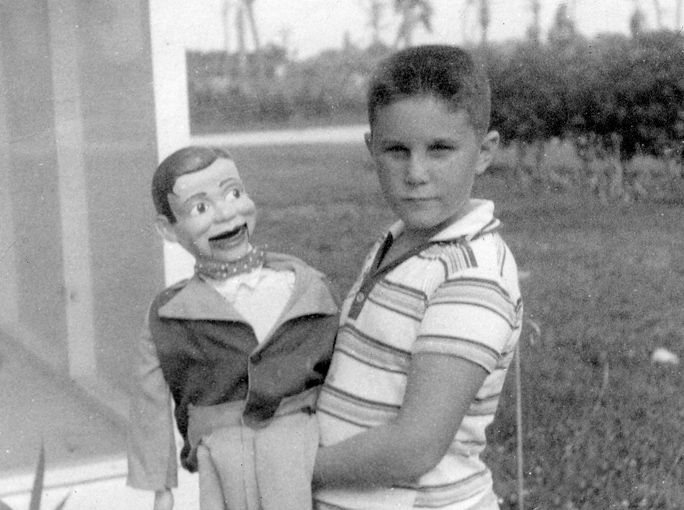 |
| Jerry Mahoney and Paul Winchell |
Mike and his own Jerry in St. Petersburg, FL. (1962) |
T V T' and Me
By Mike Clark
|
The Big 13 site was created by
former
WTVT employee
Mike Clark. |
|
|
 |
| Jerry Mahoney and Paul Winchell |
Mike and his own Jerry in St. Petersburg, FL. (1962) |
My interest in the production side of TV began in the late 50's when I watched Paul Winchell and his dummy Jerry Mahoney. Winchell's show was so clever, witty, and inspiring that it made me want to discover how the TV magic was done. (Winchell also sparked an interest in ventriloquism and puppetry, but that's another story and another web site!).
In 1960, my father took me to see the studio of WSUN, Channel 38 in St. Petersburg. Located at the Million Dollar Pier, WSUN was a modest facility but I was able to see a TV camera, stand behind it, and change lenses. Seemed like fun!
WSUN...my first visit to a TV station.
This fellow
is working an RCA TK-11A camera with a turret lens
The next year, my third grade class performed "The 500 Hats of Bartholomew Cubbins," at WEDU's studio located within St. Petersburg Junior College. Again, I was fascinated with the cameras, lights, microphones, and video tape recorders-- and pop-eyed when the show aired and we could see ourselves on TV!
I spent many afternoons and weekends with the TV tuned to WTVT, Channel 13. Their local on-air programs were my favorites. Mary Ellen, 3-D Danny, and PULSE news was great. I sent away for Roy Leep's 'Hurricanes' book, even though I had no idea what to do with it...I just liked the drawing of the WTVT tower on the cover!
Neat drawing, eh? And you can track hurricanes, too!
|
|
Since Florida is flat as a pancake, the WTVT tower was a terrific landmark. Whenever we traveled through Tampa to Orlando I would always spot it from I-4. Returning from Orlando, I knew when I saw the tower that we were near home. |
In 1962, WTVT aired a new series from England called Supercar. Wow! This show knocked me for a loop. Terrific characters, stories, and special effects made me want to learn even more about making TV shows.
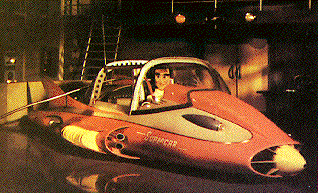
"The Marvel of the Age" - SUPERCAR.
WTVT carried
this popular British series in prime access.
Terrific characters and
special effects have made this series a cult classic.
On my 10th birthday, I made the trek from St. Petersburg across Tampa Bay to the studios of WTVT. I was going to be on "The Mary Ellen Show," and couldn't be more excited. I took along my Ansco still camera and shot pictures outside the studio and on the set during commercial breaks.
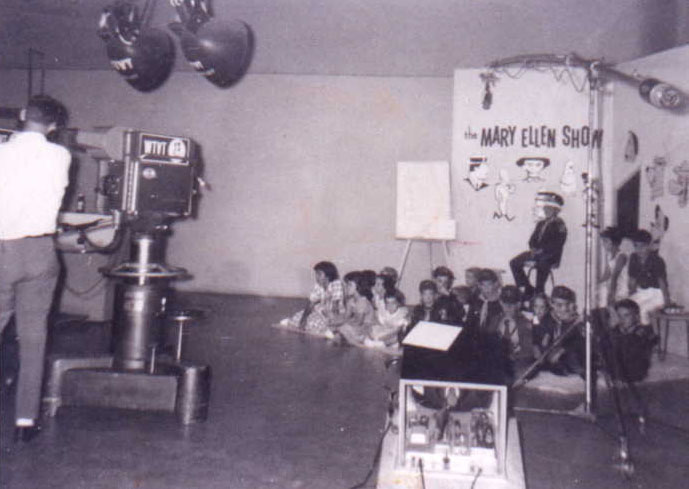
As I walked around taking in the cameras and crew, I knew that I had to get into this magic world of television.
Since there was no home video in 1962, I did the next best thing and made cardboard TV cameras and pretended to stage TV shows. For three-camera productions, I built small cameras out of wooden blocks. With my record player cranking out a theme and me directing, my shows usually went off without a hitch.
I enjoyed the "The Red Skelton Show" because of the humor and the fact that it was almost a 'live' show. Taped at CBS Television City in Hollywood, Skelton's show used 4 cameras, and I watched the program carefully to study camera angles and live switching. I figured that Television City would be a place I'd like to visit some day. On NBC, I followed a program called "That Was The Week That Was," which took the usual rules of television and turned them around into a very innovative, funny presentation.
I appeared on WFLA's "Uncle Bruce" show on my 11th birthday in 1963. During a cartoon, I talked to a cameraman about his Zoomar lens and how it worked. He seemed amused that an 11 year-old kid would want to know how his camera was operated. I finagled another visit and tour of WTVT, starting a tradition of studio tours in whatever town we passed through that was large enough to have a station. I eventually visited WDBO, WFTV, and WESH in Orlando, WINK in Ft. Myers, and toured the original WLCY studio in an old office building on Central Avenue in St. Pete. I returned again to Channel 13 in 1966...once on a visit to the St. Pete studio....
15 years old and can't keep my hands off this TK-42
...and another visit to Tampa facility.
Because of Supercar and another terrific Gerry Anderson series, Fireball XL-5, I was ready to embrace "The Outer Limits," which premiered on ABC in 1963. This show had the most outstanding photography of its time due to the efforts of Conrad Hall, who won an Academy Award for "American Beauty.
|
The crew of FIREBALL XL-5 as seen Saturday |
"Do Not attempt to adjust your set...we are controlling all that you see and hear on THE OUTER LIMITS." |
Irwin Allen's series "Voyage to the Bottom of the Sea," "Lost In Space," and "The Time Tunnel", along with "Star Trek" cemented my interest in TV and production. I should also mention some other favorites..
|
|
|
|
|
|
...like Batman, The Man From U.N.C.L.E., Laugh-In, The Avengers, Hullabaloo, Mission:Impossible, Get Smart, The Wild, Wild West, Sky King, and others too numerous to list here.
During junior high school in 1967, I went back to WFLA and appeared on their teen dance program, "HI TIME". Channel 8 was color by then and I spent some time between dance numbers studying the TK-42 cameras.
|
|
WFLA (1967) In Studio A for HI TIME, a dance program. Groovy!
In 1968, my family moved to Syracuse, New York. I had turned 16, and was just old enough to become a volunteer at WCNY-TV, a PBS station.
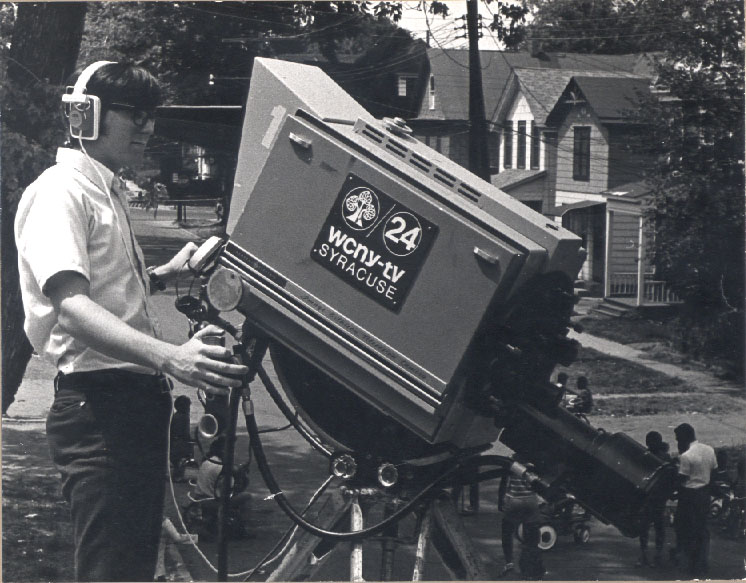
Me at WCNY in 1969. Although this camera is big, it's still
black and white.
You should see the size of the color cameras!
WCNY was typical of PBS stations of the time. Even though every commercial station was color by 1968, WCNY was still in black and white. Their Marconi studio cameras were inherited from The Ed Sullivan Show, and had been used on the Beatle's first appearance in 1964! My boss, production manager Bill Upwood, wanted me to work with prime lenses before graduating to zooms. As a cameraman, this taught me to think about focal lengths and not overuse a zoom once I used one. I spent hours practicing my camera work until I was one of the best operators at the station. I learned about lighting, audio, painting a set, floor managing, and more, because at a PBS station, a production person had to be able to 'do it all.'
Our remotes were just as tough as any I later did at Channel 13. Syracuse is in the snow belt of the northeast, and I spent many evenings driving through blizzards to help set up a remote at a hockey game or concert. The hours were long and my grades at school suffered, but it didn't matter because I loved it all. The lights, cables, rigging, and equipment have an atmosphere that I really dig. Anyone reading this who has television in their blood knows just what I mean.
Returning to Florida, I attended St. Petersburg Junior College for two years beginning in 1970. Their radio/TV school hadn't changed a bit since I was there for "Bartholomew Cubbins" in 1961...I think even the cameras were the same! I managed to get a part time job at the local TelePrompTer Cable TV channel 7, which had a small studio in a former Gulfport pizza parlor.
|
|
|
The studio's cameras were a new generation of RCA industrial color cameras that barely made a color picture, and the zoom hardly worked either. Still, I managed to make the most of it behind the scenes, while acting as news anchor, entertainment editor, and kid's show host in front of the camera (I guess you could say I was the "Paul Reynolds" of cable TV!). My kid's show eventually morphed from showing old Paul Terry cartoons into original comedy sketches (think of 'Saturday Night Live' without any money or stars in a 15 foot-wide studio).
In a homage to Channel 13's '3-D Danny,' I created "Captain Spacey," a bumbling 21st Century Hero who also fought robots and villains from his spaceship.
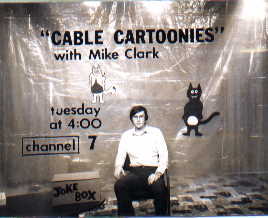
Promotional slide from my show "Cable Cartoonies"
Meanwhile, WTVT beckoned from across Tampa Bay. I had the opportunity to go to BIG 13 to help promote a play that was being staged at the St. Petersburg Little Theater. As the show's soundman, I had assembled a musical tape that would provide a background for musical numbers to be performed live on Pulse Midday. The station's audio man, 'Red' McMurrow, grumbled as I handed him my edited 1/4" tape. Worried that the splices might not hold, I asked him to run a few seconds. He did, the tape worked, and then Red left the booth. I decided to play another couple of seconds when Red came back in. "What're you doing??!!" he yelled. Ooops! I backed out of there pretty fast.
Knowing that I would attend the University of South Florida in Tampa once my two years at SPJC were finished, I dropped by WTVT every once in a while to lobby for a job. For years I had 'champed at the bit' to work there and join the people who made such excellent local television. I've always been a 'CBS' kind of guy, and knew that I would fit in...I had to try to get in the door.
Having a good work resume from WCNY and Teleprompter, I felt confident that somebody would recognize my ability, even if I was only 19 years old. Jim Benedict, WTVT's assistant production manager, was the fellow who gave me another tour and listened to my pleas for a job. Jim couldn't have been nicer, and told me there were no openings at the moment but to stay in touch. No problemo!
In the summer of 1972 I made my move to attend USF in Tampa, and checked in again with Jim. Miracle of miracles, there was a part-time opening on the production crew! Jim probably felt sorry for the skinny kid who wanted so desperately to work at 13. When he said 'you're hired' I must have spun like a top.
The tower looked pretty tall to me the day I reported for work
A few days later, I parked my car in 13's lot, and strode up the back way towards the employee entrance. My heart beat faster and I held my breath...would I actually get through the door? Or will they suddenly think twice and rescind my employment? If I get in, will Red McMurrow remember me and yell again?
Well, I made it in, and never lost the sense of pride I felt every time I went through that entrance.
My 'official' WTVT portrait.
WTVT is located at 3213 W. Kennedy Blvd.. The phone number is (813) 876-1313. Once employed at WTVT, you were part of something really important to the Tampa Bay area. Your work would be seen every day in thousands of homes. The work you did would effect people's lives. It was like being part of the elite. After all, not everybody in the Tampa Bay area knew where Joe's garage or Ed's sandwich shop was, but EVERYONE knew WTVT. I remember applying for a loan once...I was about 20 years old and certainly didn't look like a good credit risk. The loan officer was about to give me the brush off. When he asked where I worked, and I told him "WTVT," he smiled and immediately approved the loan. Working for such a highly regarded local institution didn't carry much sway with my girlfriends, but it did help by impressing their parents.
Like all large organizations, WTVT had a culture. I quickly observed that the news people were at the top of the WTVT food chain. Hugh Smith, 'Salty Sol,' Andy Hardy, and Roy Leep were the 800 pound gorillas. Generally, they didn't throw their weight around because it wasn't necessary...who wanted to give news, sports, and weather any grief? Not us on the production crew. Besides, I had grown up watching these people and was somewhat in awe.
Middle management pretty much kept to themselves while the crew ran production. Since most of us were pretty young, we probably seemed a little anarchistic to the generation proceeding us. We were the first batch of liberal, somewhat cynical folk who combined the free-spirited, hippy mentality of the 60's with the casual sexual attitudes and distrust of authority of the 70's. It was a time of scandals like Watergate, and we actually believed that politics would change for the better when we voted for McGovern in the '72 presidential election. We wore our hair long and sported long sideburns and sometimes mustaches and goatees. Lighting director Gil Muro started a food co-op for the production crew. I even heard (but never saw) that some of the guys smoked marijuana. We read the National Lampoon magazine and listened to their radio show.
We took our jobs seriously, but we took our fun seriously too. There are plenty of risqué tales from out of town remotes that I can't reveal here because....well, because it ain't that kind of web site! Picture a crew full of twenty-somethings out of town, and you pretty much get the idea. Late nights and hazy, hungover mornings were pretty much the norm, and our young bodies took a lot of punishment.
Anyway, I think we did a good job AND managed to freak out some of our colleagues at the same time. In the section "Meet the Staff of Channel 13", you can get my personal take on my co-workers and the people who appeared on-air. Don't look for any hatchet jobs, though...it ain't that kind of web site!
I'm finding it difficult to remember my first few days at 13. Studio work was not anything new to me, so I must have watched and learned for a short time, and got on camera pretty fast. After working with TeleprompTer's primitive color equipment, I was very impressed with the pictures put out by the station's G.E. PE-400s. You put a pink gel on a light, and it actually showed up pink! It took some effort to get those 500 pound beauties rolling across the studio floor, but I did it with no complaints.
For the next five years, I did it all...camera, flooring, lighting, set building, painting, staging, Vidifont, and a little producing and directing. I worked on Pulse, Breakfast Beat with Ernie Lee, College Kaleidoscope, High-Q, Black Contact, Publix commercials, Pulse Plus! and so on. Five years may seem like a short time, but I feel that I gained ten years worth of experience at BIG 13.
Me running a PE-400 on HIGH-Q.
Can you name the country's
15th President? I couldn't!
With Channel 13's remote unit, I traveled the state and worked on football, baseball, commercials, and syndicated shows.
A Remote at Busch Gardens.
Todd DeBonis (Brown shirt) and
Gil Muro operate the Norelco PC-70s.
Back at the studio, I got to know the on-air staff and watch them in action on the set of Pulse. It was like being with the Yankees...a winning team at a winning station.
One particular stunt almost got me fired. I wanted to push the envelope and produce a show that used all of 13's facilities to the max. I had co-produced a few segments of "Church Service" with Father Desmond Daly, a local priest who staged programs for the Catholic Diocese of St. Petersburg. I convinced Father Daly to do a dramatic production for one 'Church Service' that dealt with life, death, and spirituality. I wrote the script to suit our production capabilities. The story was a 'Twilight Zone' kind of fashion, where the characters are deceased and gathering in a heavenly waiting room (The 'White Room'). They relive some events from their lives in flashback.
The infamous "White Room". We moved a camera onto an electric lighting ladder to get a high angle. This program almost got me fired!
I was directing, and from a production standpoint, it was very involved, calling for sets depicting the 'White Room,' a bedroom, a hospital room, an office, an airplane, a backyard, blue screen with the interior of moving car, and some location shots as well. The shooting would take multiple days and would have to be sandwiched between live programming and other commercial production. I thought it would not only show what could be done out of Studio B, but it would be an excellent demo reel for me. The main problem is that I was 24 years old and writing about themes I hardly knew anything about!
Still, we pushed on and actually shot some fairly decent segments until our production manager, Dan Boger, found out how extensive my plans were. Dan gave me quite a dressing down but came just short of canning me. I quietly finished shooting, and edited the drama tape-to-tape using the Ampex AVR-1s. I think the final result, called "Where Do We Go From Here?", pretty much impressed everyone who saw it, but I decided to keep a low profile after that and just do my regular job.
There were some tense moments between management and production when the crew looked into union representation. The general feeling was that we were working very hard and not receiving adequate compensation. Whether that's true or not, I don't know...the books were never opened for us. Nonetheless, management was quite piqued when we held several meetings with union representatives to discuss the situation. Eventually, we did not vote for union representation and the issue, if not some hard feelings, went away.
By 1977, I wanted to move up and become a Channel 13 producer and director, but I looked at the staff list and noted who had seniority over me. Just about everybody! To become a producer and director at 13 might take an additional 10 years or more, and I didn't have that kind of patience. (in fact, my boss Jim Benedict remained there for another 30 years!) It was time to leave, and I moved to Los Angeles to continue my career.
By the time I made it to Hollywood, though, they weren't making shows like "Red Skelton" and "Lost In Space." Carol Burnett was winding down, and Norman Lear's company had another two or three years of shows before things got quiet. I couldn't find a job as a cameraman, so I took a position in video equipment sales, figuring that I would meet some people in the industry. That hunch proved correct and I soon went to work for a small company that produced movie trailers and syndicated shows. I became an editor and by submitting some demo spots to 20th Century Fox, won the company a prestigious job doing Star Wars commercials for the 1978 re-release. Small companies, however, live from client to client and I had to diversify. I went free lance, producing industrial training tapes, commercials, or even videotaping weddings and bar mitzvahs.

Mike with Bob and Dolores Hope
I was lucky enough to meet and work with some TV legends. I mean the REAL kings of comedy...Bob Hope and Milton Berle. I worked on several Hope specials as the editor of 'classic clips' from the 50's, 60's, and 70's. It was a dream job, and being around Hope's crowed was amazing. At one event at Hope's Toluca Lake home, I was able to see George Burns, Danny Thomas, Jimmy Stewart, Phyllis Diller, Dorothy Lamour, former President Ford and his wife Betty...all in one room! It was like watching a movie, only everyone was real and in 3-D.
In 1984, I was hired at Columbia Pictures Television to run a small editing suite and manage a tape library. Over the years, the job expanded to two high definition edit bays. I'm was a hands-on producer and editor (and sometimes cameraman) for on air promotion, sales tapes, and electronic press kits. You've probably seen episodic promos I've produced for Seinfeld, Mad About You, Just Shoot Me, Married With Children, Designing Women, The King of Queens, and a few other comedy classics. After 25 productive years at Columbia/Sony I was downsized in 2010 and now free lance with my own company, Clark Media Productions.
I've remained long-distance friends with many of my Channel 13 alumni. Fortunately, my best pals have joined me here in Los Angeles, and we see each other regularly. I think the reason for the fact that my 13 buddies are still close friends is that WTVT was actually my college, and my co-workers were my frat brothers! Sometimes we certainly acted like 'Animal House'.
For 15 years, I was also a feature writer for Starlog magazine, which enabled me to meet many of the producers, writers, directors, and stars that I had loved so much. Among the people I interviewed were Irwin Allen and the cast of Lost In Space, British producers Gerry and Sylvia Anderson, Gloria Winters ("Penny") from Sky King, and many more.
|
|
|
I also met and befriended the man who originally inspired my interest in TV, Paul Winchell. To my delight, 'Winch' asked me to help him and a close friend named Jerry Layne produce a home video about ventriloquism. To me, working with and spending time with a genius like Paul Winchell was one of the highlights of my life. His passing in June of 2005 was a personal loss and the entertainment world lost a true genius.
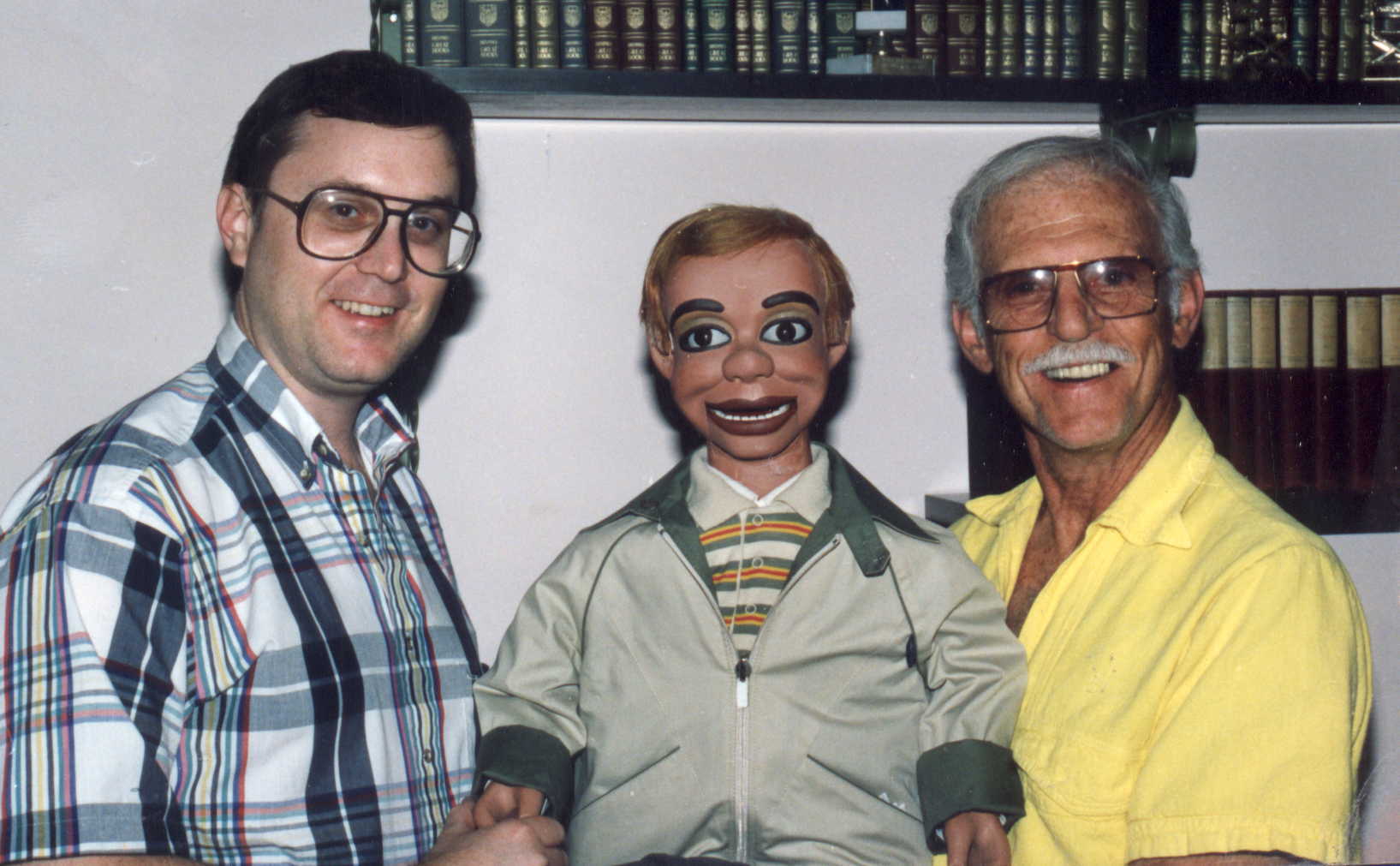
Full circle! I meet Paul Winchell and Jerry Mahoney,
whose programs are what got me interested in TV.
Winchell is a genius: Did you know that he held a patent for creating the
first working artificial heart!
When I started the BIG 13 web site in 2001, I couldn't have known how popular it would become with Channel 13 employees past and present. Many viewers who grew up in the Tampa Bay area have also discovered the site and shared their fondness for the station's history. All this energy culminated in the 2005 WTVT Employee reunion, which I produced in Tampa on April 2, 2005. 250 current and former employees joined together for a celebration of the station's 50th anniversary and it was an evening we'll never forget. You read about the reunion by following THIS LINK
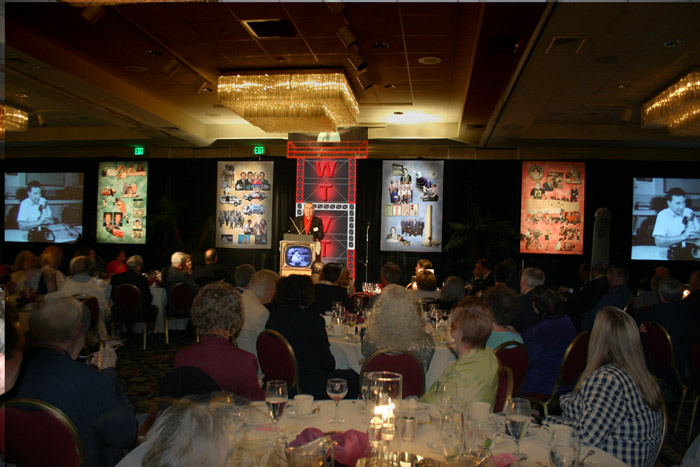
THE 2005 BIG 13/WTVT EMPLOYEE REUNION
I shouldn't forget to mention that I married my sweetheart, Jodi Kohl, from St. Petersburg. Our 1978 wedding was held in St. Pete at The Pier on the very space where I once stood behind a Channel 38 camera. The ceremony was attended by many friends from Channel 13. Jodi and I were married for 29 years until she passed away from cancer in September of 2007. My WTVT colleagues were generous with their support and I will never forget their kindness. My daughters, friends, family, and work have kept me on an even keel after this personal tragedy. Those who have lost loved ones understand well the ups and downs of healing. In the meantime, I try to maintain a positive attitude about the future.
My younger daughter is following in my footsteps with her interests in photography and video. She produces excellent photos and has been published in local newspapers and magazines. The photos from our 2005 reunion are mostly Sara's, who stepped in for our main photographer who was dealing with a family emergency. So watch out in the future for Sara Michele Clark!
A holiday card from the Clark family.
(left to right)
IN CONCLUSION
Well, here it is...the 21st Century. I'm not the same guy I was walking into 13's employee entrance in 1972, and WTVT is not the same station. I won't say whether that's good or bad, because change carries a little of both. Economics, additional TV networks and cable channels, the internet, and changes in ownership made Channel 13 what it is today. Since I no longer live in the Tampa Bay area, I'm not in the best position to judge the station's impact on the local level. However, as a result of the research I did preparing for the BIG 13/WTVT Employee Reunion I was able to learn what had transpired since I left in 1977. It was an amazing tale of technology and growth, capped by the switch of WTVT from a CBS affiliate to Fox in 1994. While many (including me!) predicted doom, the management of WTVT succeeded in keeping the station on top by leading in news and retaining the on-air staff.
When the station's 50th anniversary celebration occurred on April 1st, 2005, it was joyously feted on-air with promotional spots, live interviews with former employees (including yours truly) and the grand employee reunion the following day. It was a wonderful merger of the past and present and all of us felt kinship with the many people who had been through the doors of 3213 West Kennedy Blvd.

Tony Zappone, Larry Elliston, Kathy Fountain, Roy Leep, and Mike Clark
talk about WTVT's 50th Anniversary (April 1, 2005).
Thinking back on the days long passed, I wonder just how all those talented people came together at 13, both in front of the camera and behind it. I've never worked with a more dedicated group of guys than those in 13's production department. To a man (or woman), they were trying to make great television by doing the best camera work, directing, and staging possible. Everyone was highly charged and wanted to make Tampa into a 'little Hollywood.' What attracted all this talent? And why to 13?
This can't be answered in any fashion except to say it was 'lightning in a bottle.' The right people, the right equipment, and the company willing to back it up. All those elements rarely fall into place. That era started before I arrived and continued
after I left. The BIG 13's web site's historical range begins with the FCC hearings for Channel 13's license in 1954 and concludes around the time the original WTVT studio building was demolished and replaced by the current facility.My 'Big 13' web site is a time capsule of an era 'Gone With The Wind.' I miss it, and hope that in the future, lightning will be captured in that bottle once again.